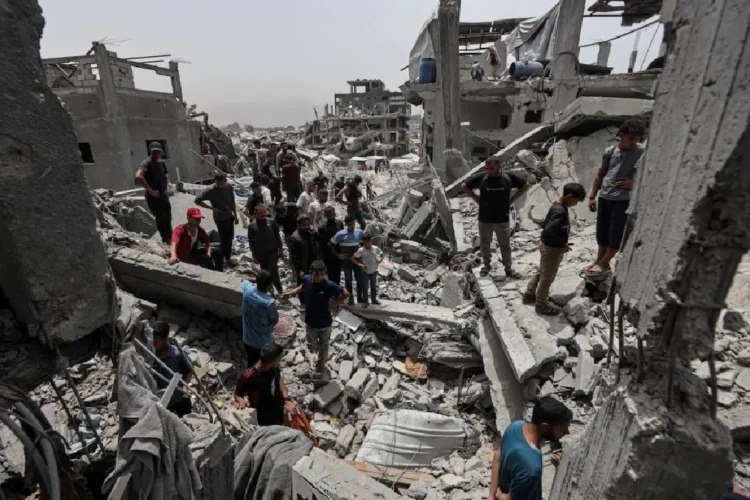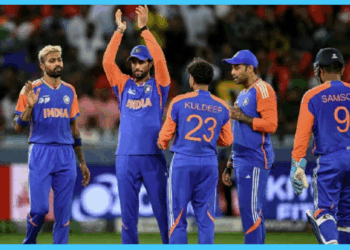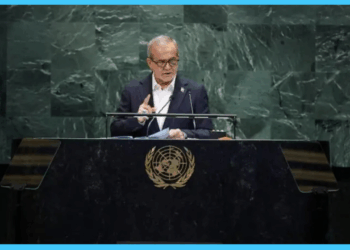GAZA; Gaza is teetering on the edge of full-scale famine as the humanitarian catastrophe worsens under Israel’s continuing military campaign and blockade. At least 91 Palestinians have been killed in recent weeks while trying to access aid, according to local health officials and humanitarian agencies. The deaths, reportedly caused by Israeli gunfire targeting crowds gathered near aid trucks, have sparked global condemnation and intensified calls for immediate international intervention.
The latest deaths come amid repeated incidents over the past month where Israeli forces have opened fire on starving civilians during chaotic food distributions in northern and central Gaza. On multiple occasions in July alone — including deadly episodes near Gaza City’s Nabulsi Roundabout and Al-Rashid Street — dozens of Palestinians were killed or wounded while waiting for flour or food packages. Eyewitnesses and medical teams describe scenes of desperation as crowds scramble for limited aid under sniper fire or drone surveillance.
Famine Death Toll Rises
At the same time, starvation continues to claim lives at a chilling pace. At least seven more Palestinians, including children, died of hunger-related causes this week, bringing the total number of famine-linked deaths to 154 since the start of the year. Of these, 89 are children — victims of acute malnutrition, dehydration, and the complete collapse of the healthcare system.
Gaza’s health authorities and aid organizations have repeatedly warned that the territory is already experiencing localized famine, particularly in the north, where aid access has been sporadic or entirely cut off for weeks.
Pattern of Deadly Aid Ambushes
Since early July, Israeli attacks near aid convoys and food distribution points have become disturbingly frequent:
- July 2: At least 20 people were killed in Gaza City when Israeli forces shelled a group gathered near an aid distribution point.
- July 9: Another 14 were reportedly killed by Israeli sniper fire near a food convoy in Beit Hanoun.
- July 15: Israeli drones fired on crowds lining up for water and flour in Jabalia, killing 17 and injuring dozens more.
- July 22: Eyewitnesses described tanks firing on people collecting wheat bags south of Gaza City, with at least 10 fatalities.
These incidents follow a similar pattern to the infamous “Flour Massacre” of February 2024, when over 100 Palestinians were killed near Al-Rashid Street while collecting food from aid trucks — an incident that drew international outrage but little substantive change in policy.
Aid Blockade and Infrastructure Collapse
Despite mounting death tolls, humanitarian operations remain obstructed. The Israeli-imposed blockade, now in its 11th month, continues to severely limit the flow of food, fuel, medicine, and clean water. UN agencies report that just a fraction of the required aid is entering Gaza, with many trucks stuck at border crossings or turned away by Israeli authorities citing “security concerns.”
With hospitals destroyed, sewage systems collapsed, and bakeries shut due to fuel shortages, civilians are left with no access to basic services. The World Food Programme (WFP) and UNRWA have repeatedly warned that famine could engulf the entire population if safe, unimpeded access is not restored immediately.
Global Reaction and Pleas for Ceasefire
In response to the growing crisis, international human rights groups, the United Nations, and several governments have condemned the attacks on civilians and urged an immediate ceasefire. UN Secretary-General António Guterres described the situation as “a moral outrage” and called for unrestricted humanitarian access.
However, diplomatic efforts have so far failed to produce a lasting ceasefire or pressure Israel into allowing significant aid access. The United States and other key allies have continued to supply military support to Israel, even as civilian casualties mount.
A Crisis Without Precedent
Analysts warn that without swift global intervention, Gaza may face irreversible humanitarian collapse. “We are watching an entire society being starved, bombed, and abandoned in plain sight,” said a spokesperson for Médecins Sans Frontières (Doctors Without Borders). “Every day of inaction costs more lives — mostly children.”
The death toll in Gaza since October 2023 has now surpassed 38,000, with over 85,000 injured, according to the Gaza Health Ministry. With entire neighborhoods reduced to rubble and famine spreading rapidly, the people of Gaza face a dual threat: death by war or death by hunger.

























